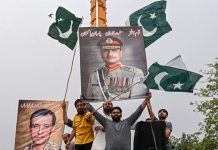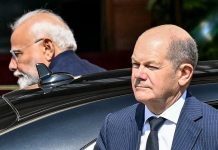Has India been interfering in Nepal’s politics via RAW – its intelligence agency? Nepal foreign minister Pradeep Gyawali is on a three-day visit to New Delhi starting from January 14 amid an internal political crisis in the tiny Himalayan nation.
While Kathmandu is looking to procure Covid-19 vaccines from India, Gyawali could also discuss the India-Nepal border row and other bilateral issues.
The timing of the visit assumes significance as it comes in the wake of China trying to meddle in Nepal’s internal matters, a cause of concern for India. Last month, Nepal’s President dissolved the parliament and announced fresh elections, following which Beijing rushed a high-level delegation to Kathmandu to “take stock” of the situation.
Then, the Chinese ambassador to Nepal Hao Yankee held a “secret meeting” meeting with President Bidya Devi Bhandari at the presidential palace in Kathmandu. It is clear that Communist China wants to have a say in Nepal’s internal matters involving the Nepal Communist Party (NCP), which is hit by a power tussle between Prime KP Sharma Oli and former Maoist guerrilla leader Pushpa Kamal Dahal ‘Prachanda’.
While officially India distances itself from this issue by saying “these are internal matters for Nepal to decide as per its democratic processes”, New Delhi would never want Kathmandu to be a puppet in the hands of Beijing. And so far, it has been successful in creating a rift within the NCP much to the discomfiture of China.
..Foreign Secretaries and other high level officials from both sides.
The JC meeting was preceded by a restricted meeting between the two Foreign/External Affairs Ministers, accompanied by the Foreign Secretary and the Ambassador of Nepal to India on Nepali side; pic.twitter.com/K1jEDtKqlP— Nepal Embassy, India (@EONIndia) January 15, 2021
Interestingly, on the eve of Gyawali’s New Delhi visit, Prachanda had accused the Prime Minister KP Sharma Oli of splitting the ruling NCP and dissolving Parliament at India’s behest.
“Now did Oli split the party and dissolve the House of Representatives at the direction of India?” the former prime minister asked, addressing a meeting of leaders of his faction of NCP in Kathmandu.
Prachanda also alleged that India’s external intelligence agency, Research and Analysis Wing (RAW), was in touch with Prime Minister Oli.
“Oli met Samanta Goel, the chief of R&AW, the intelligence wing of India, for three hours at his official residence at Baluwatar, without the presence of any second person, which clearly shows Oli’s motive,” Prachanda was quoted as saying by news agency PTI.
Oli had earlier said he was forced to recommend the dissolution of the House to the President after learning that the Prachanda-led NCP faction was planning to file a no-trust motion against him.
Did Nepal Get A ‘RAW’ Deal?
India shares an 1100-km border with Nepal and the two nations have been maintaining friendly ties for centuries. Hence New Delhi has a genuine interest in the Himalayan nation. In fact, India’s RAW chief Samant Kumar Goel did visit Kathmandu in October last year, days before Indian Army chief MM Naravane’s tour of the country.
Goel and Naravane’s visits were intended to clear doubts over India’s construction of an 80-km strategically important road connecting the Lipulekh pass with Dharchula in Uttarakhand on May 8. Kathmandu had raised objections claiming the road passes through its territory and came out with a map.
India had said that Nepal was reacting under pressure from “someone else”, dropping broad hints that it was none but China. This border tangle, which soured the relations between the two countries, could be discussed during the Nepalese foreign minister’s meeting with his Indian counterpart S. Jaishankar on Friday.
Nevertheless, it’s a fact that the Indian intelligence agency has been actively involved in Nepal’s internal affairs for decades. In his book, Battles of The New Republic: A Contemporary History of Nepal, journalist and author Prashant Jha has described how RAW plays a critical role in Nepal’s politics.
A former RAW official was quoted as saying, “My organization’s engagement with the Maoists began in 2003. It was also the time when they were in talks with the king’s nominated government back in Nepal.”
The author quoted another RAW official who said, “If you have an open border, there has to be a special security relationship. We could have lived with a Maoist dictatorship if it was 5,000 miles away but, across an open border, we cannot risk it.”
This indicates that India does not want the Maoists to rule the erstwhile kingdom. No wonder, that current RAW chief, during his October visit to Nepal, had met former Maoist leader and colleague of Prachanda, Baburam Bhattarai, who had studied at Jawaharlal Nehru University in New Delhi.
Bhattarai, who was Nepal Prime Minister between August 2011 and March 2013, is now chairman of Janata Samajbadi Party. He is known to have close links with many Indian leaders and naturally, New Delhi wants to retain him by his side, if not officially, but by other means.
Countering Chinese Influence
One thing is certain that India has been indirectly doing the groundwork to strengthen its ties with Nepal in view of rising Chinese influence over Kathmandu. Ever since NCP came to power, Beijing has been closely involved in Nepal’s affairs in the garb of providing economic and developmental assistance to the country battered by the decade-long Maoist insurgency – from 1996 to 2006.
Amb @nilacharya paid a courtesy call on the Chief of Defense Staff of India Gen. Bipin Rawat at latter's office and had a warm discussion on friendly relations between the two countries. pic.twitter.com/H7TeAbPk8C
— Nepal Embassy, India (@EONIndia) January 14, 2021
China overtook India as the biggest foreign investor in 2014. Almost 90% of FDI in the last fiscal has come from China and Beijing had promised $500-million assistance to Nepal in October 2019, according to German News agency DW.
China has invested heavily in infrastructure and hydropower projects with Nepal being a partner in Beijing’s ambitious Belt and Road Initiative (BRI). China is also planning a railway track connecting Kathmandu and Shigatse in Tibet as part of its BRI. The move is aimed at boosting trade and tourism prospects for Nepal, and easing its reliance on India.
India, of course, cannot match China when it comes to investment, but New Delhi would seek to extend its influence over Nepal through diplomatic and other channels. For India, political stability is more important than trade and business relations. The decade-long Maoist violence in the country was a wake-up call for India given that India itself has been plagued by Left-wing extremism in several states.
Intelligence reports had earlier indicated that the Maoists in India was planning to build what they called a ‘Red Corridor’ from Nepal to Andhra Pradesh in India. However, the plan failed after the Maoists laid down arms and established a democratic government overthrowing the Nepal monarchy.
This had offered New Delhi a temporary relief, but the Maoist domination in Nepal’s politics continues to remain a cause of concern because of the China angle. It is yet to be seen how effective the Modi government’s ‘Neighborhood First’ policy is in countering the growing Chinese influence in Nepal.
Follow EurAsian Times on Google News




